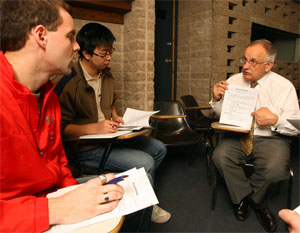 |
| Master's student Stephen Petersen and PhD candidate in oceanography Yuehua Lin discuss their C.V.s with workshop leader Sunny Marche. (Nick Pearce Photo) |
You’ve done your course work. You’ve completed your research, written your thesis and defended it. Now what?
It’s time to get together that all important curriculum vitae.
For those of us who don’t know Latin, a curriculum vitae is basically “the story of your life,” informs Sunny Marche, Associate Dean of Graduate Studies. He recently presented the session, Building a More Effective Curriculum Vitae, to a roomful of graduate students.
Also called a CV, a curriculum vitae is more detailed than a resume, which is usually kept to one or two pages.
“A CV is a sales document,” says Dr. Marche, whose own CV runs to eight pages and can be tailored depending on what audience it is being used for. “And the product you are selling is you.”
Dr. Marche has some definite ideas on what a CV should contain—and what it shouldn’t. Namely, don’t include your photograph, your height, weight, age and any wacky hobbies, unless they’re relevant to the position you’re applying for. “You want to avoid anything that might result in a quick no,” he says.
Things to include are: contact information, educational details (without going back too far), a summary of relevant employment history, funding sources, awards, publications and works in progress, papers/presentations/panels, teaching experience, and professional and academic associations.
References should be made available only on request.
His advice extends to what kind of fonts to use: a clean, sans serif font for headings—“they hold the eye longer” —and a serif font for the text. He also recommended forgoing fancy paper stock and instead using a high-quality white paper that can be easily photocopied.
The most important thing about preparing your C.V. is to check and double-check that the grammar is correct and everything is spelled right. Having a potential employer find a typo is a sure-fire way to have your C.V. tossed on the reject pile, says Dr. Marche.
“Proofread it. Typos mean that there’s been a lack of attention to detail,” he stresses. “And get a second pair of eyes to read it over too.”
That’s ditto for your covering letter.
Once your C.V. is prepared, its key to keep it updated. Add papers you’ve had published and conferences you’ve presented at so that it’s up-to-date and ready to go.
After spending six years on his interdisciplinary PhD, Al Joseph says a refresher on how to write a C.V. is just what he needed.
“I’ve been at this for so long that sometimes what you need is some straight-ahead, practical advice,” says Mr. Joseph, whose area of expertise is renewable energy. While looking for a job is “a source of anxiety,” he adds, “I’m looking forward to it at the same time.”
“I’m usually pretty polite in saying what my strengths are,” says Vaneeta Kaur Grover, who is heading to Edmonton to join her fiancé with her PhD in statistics in tow. “What I heard from Dr. Marche is that this is no time to be shy. You’ve got to get out there and present yourself.”
